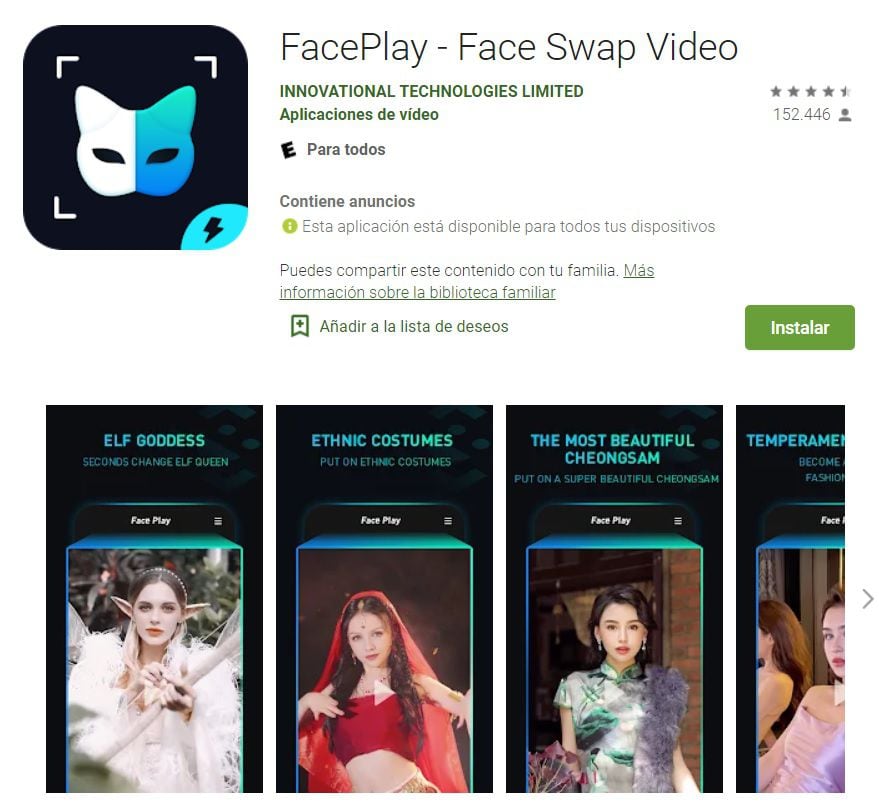
It is known as deep fakes to videos and photos with quasi-perfect ensembles where the face of one person is combined with the body of another; or when two faces are merged into one. This technology, which relies on a machine learning system and an important set of data, allows us to generate all kinds of realistic results.
Here are some applications that allow you to create this type of content in just a few steps. They are options that seek to offer a tool that can be very entertaining.
1. Reface

Reface, formerly called Doublicat, allows you to crop photos and videos to give free rein to the imagination. One of the most outstanding features is that it allows you to exchange faces or put the user's image in different clips. You can combine faces, create memes and add filters.
It has a wide variety of content and options. In this app, as in all of its kind, the user must enable access to the camera for the system to register the factions and manage to merge their image into some of the content offered. It is possible to generate video files or GIFs that can be shared through WhatsApp, Telegram and many other platforms. It is available for iOS and Android.
2. Wombo

Wombo is an application based on artificial intelligence that allows you to give movements to selfies. It is enough to upload an image of the face or take a photo on the spot, from the app, and then the system processes the content to offer, in a few seconds, a small animated video where the user is seen singing.
AI's algorithm transforms static photos into fast and expressive videos. The results may vary depending on the image being uploaded. It is important to frame the portrayed face or face well before pressing the button so that content processing begins. It can be downloaded on both Android and iPhone phones.
3. Deep Nostalgia
The Deep Nostalgia platform within the MyHeritage site allows you to animate photos. In that case it is not possible to make the images sing but simply make them move their faces from one side to the other, as well as to make winks. The tool is designed for old photos, because it has an algorithm that allows you to optimize the quality of those images.
The Deep Nostalgia feature uses several model videos to animate faces. Each model video consists of a fixed sequence of movements and gestures. The model clip guides the movements in the animation so that you can see the faces of ancestors turning their heads, blinking and smiling, as explained on the official website. To try this tool you have to go to the aforementioned website here.
4. FacePlay

There are a variety of short video templates to change the face of the clip in just one touch. The first step is to let the system scan the face and then you have to select the video you want to star in. The rest of the work is left to artificial intelligence that allows you to create a video with a changed face in a few seconds. It is available for iOS and Android.
5. FaceJoy

This photo and video editor allows you to exchange faces to put yourself in the shoes of characters and celebrities. It is possible to background, manually and use the built-in templates. The mergers are very well achieved, very realistic images are obtained. The user can add changes or edits to make the final tweaks. The application also allows you to change your gender and incorporate other types of filters. It's available on Android.
There are different machine learning systems to carry out this type of project. The most widely used and became best known linked to deep fakes are antagonistic generative networks (GAN).
These are two neural networks that compete with each other to achieve an increasingly realistic result. There is a network that is the generator and produces images; and another network that is discriminated against and is responsible for guessing, when viewing those images, whether they are real (because they come from the training data set) or if they are false (produced by the generator). This competition between networks allows us to optimize the result and achieve increasingly realistic images or videos.
KEEP READING:
Últimas Noticias
Debanhi Escobar: they secured the motel where she was found lifeless in a cistern
Members of the Specialized Prosecutor's Office in Nuevo León secured the Nueva Castilla Motel as part of the investigations into the case

The oldest person in the world died at the age of 119
Kane Tanaka lived in Japan. She was born six months earlier than George Orwell, the same year that the Wright brothers first flew, and Marie Curie became the first woman to win a Nobel Prize

Macabre find in CDMX: they left a body bagged and tied in a taxi
The body was left in the back seats of the car. It was covered with black bags and tied with industrial tape
The eagles of America will face Manchester City in a duel of legends. Here are the details
The top Mexican football champion will play a match with Pep Guardiola's squad in the Lone Star Cup

Why is it good to bring dogs out to know the world when they are puppies
A so-called protection against the spread of diseases threatens the integral development of dogs



